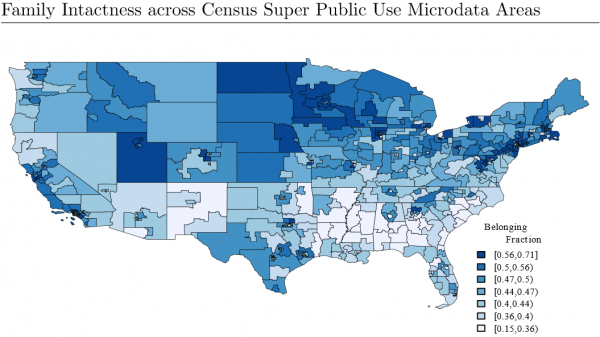Table of Contents
Effects of Family Structure on Policy Outcomes
The United States Family Belonging Index is 46 percent, with a corresponding Family Rejection Index of 54 percent, based on 2008-2012 data from the U.S. Census Bureau’s American Community Survey.1) The action of parents determines the Family Belonging or Rejection Index within a nation, region, state, or racial or ethnic group—whether they marry and belong to each other, or whether they reject one another through divorce or other means. Rejection leaves children without married parents committed to one another and to their children.
The Index of Family Belonging is determined by the fraction of children aged 15 to 17 in a given area who live with both their biological parents, who have been married since before or around the time of their birth.
The government depends on the intact family for the achievement of its stated goals. Government will likely continue to fail to achieve its goals if it continues to neglect the reality of this dependence.
1. Methodology
This research examines the influence of certain demographic, educational, and economic variables– including the Index of Family Belonging–on social outcomes of policy interest (See below for a list of the outcomes studied).
Social Outcomes of Policy Interest
- Teenage out-of-wedlock births, fraction of all births
- High school graduates, fraction of 19- to 20-year-olds
- Employment, fraction of 25- to 54-year-old men working
- Earnings, average per 25- to 54-year-old male
- Fraction of households owning a home
- Persons below poverty line, fraction of overall population
- Persons below poverty line, fraction of 25- to 54-year-old females
- Persons below poverty line, fraction of minors
- Food stamp recipients, fraction of total population
- TANF & state welfare transfers, average per 25- to 54-year-old female
- Social Security Disability Income, average per 25- to 54-year-old
- Social Security Disability Income, average per 25- to 54-year-old male
- Supplemental Security Income (SSI), average per 25- to 54-year-old male
- Supplemental Security Income (SSI), average per 25- to 54-year-old female
- Public healthcare, fraction of 25- to 54-year-olds receiving
- Public healthcare, fraction of minors receiving
- Private healthcare, fraction of 25- to 54-year-olds covered
- Private healthcare, fraction of minors covered
In effect, researchers developed empirical models determining the influences of the explanatory variables (below) on these outcomes as seen across Census geographic areas. The models show the relative importance of these influences, meaning both precision about2) and magnitude of each influence.
Explanatory Variables Investigated (Type of Variable)
- Fraction of families intact–Belonging (demographic)
- Fraction of high school graduates of prime age3) (educational)
- Fraction of college graduates of prime age (educational)
- Fraction Hispanic (demographic)
- Fraction black (demographic)
- Population density–urbanicity (demographic)
- Average age of prime-age adults (demographic)
- Average age of adults aged 40 to 60 (demographic)
- Minor dependency ratio (demographic)
- Old age dependency ratio (demographic)
- Income earned in prime age (economic)
- Household income, any type (economic)
2. Summary of Findings
When measured, family intactness always has a beneficial influence on the outcome. It is at least as effective as any other factor in influencing the 18 outcomes analyzed, and, in many cases, family intactness is the most important factor in determining a beneficial outcome across the geographic areas studied.
2.1 Out-of-Wedlock Births
Family intactness has the strongest attenuating influence on teenage out-of-wedlock birth, itself a source of economic hardship.
2.2 Education
Family intactness is very influential on high school graduation rates. It influences high school graduation rates more than the fraction of adult college graduates in an area. Family intactness and the fraction of adult high school graduates in an area have similar beneficial influences on prime-age male employment rates.
2.3 Income
Family intactness and the fraction of adult high school graduates in an area have similar beneficial influences on prime-age male employment rates.
The ratio of children to adults in an area (larger families) has a large, positive influence on prime-age male employment, and it has the largest consistently positive influence on earnings of prime-age males in the area.
2.4 Need and Dependency
Family intactness is the most important factor (or shares the place of greatest importance) in determining an area's dependence on welfare programs that target organic poverty:
- Receipt of food stamps,
- Temporary Assistance for Needy Families and state welfare transfers,
- Supplemental Security Income transfers, and
- Prime-age adult public healthcare recipiency.
Family intactness has the second-largest influence on overall diminishment of prime-age female, and child, poverty.
3. Role of Race and Ethnicity
Once family intactness, high school drop-out levels, and other demographic factors are taken into account, the fraction of blacks or Hispanics in an area rarely has a strong detrimental influence on the outcomes studied.
- The fraction of the population that is Hispanic is normally a beneficial influence or shows no precise impact and has an adverse influence on less than one-fourth of the outcomes studied.
- The fraction of the population that is black has an adverse influence on approximately half of the outcomes measured and is otherwise a beneficial or indeterminate influence.
